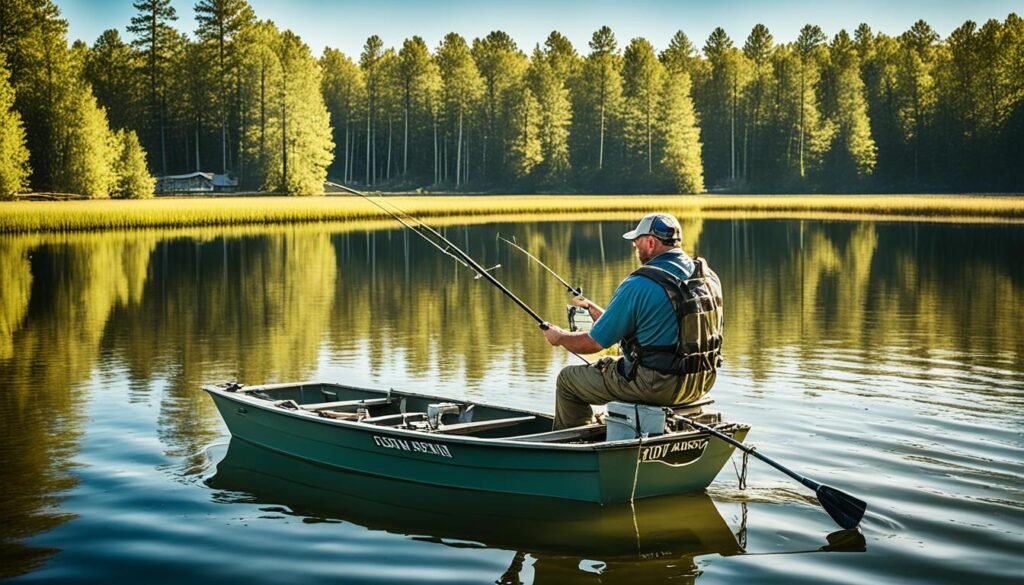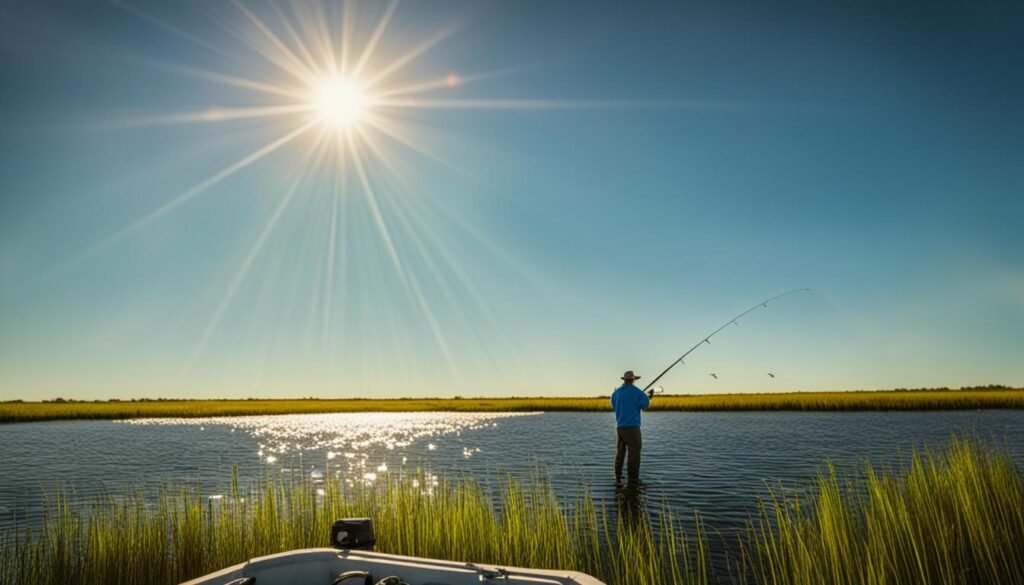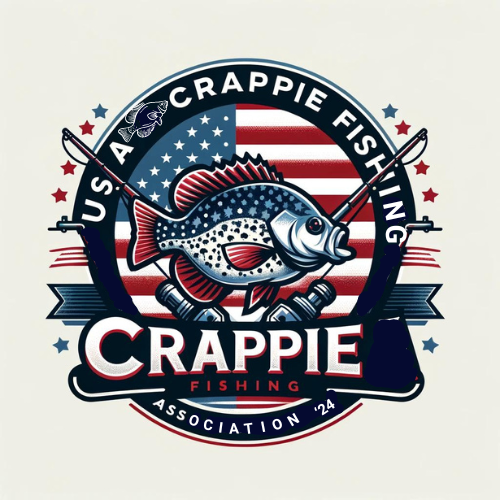When it comes to outdoor hobbies, there’s something truly special about freshwater fishing. It allows us to connect with nature, relax, and challenge ourselves in pursuit of our favorite fish. One species, in particular, has captured the hearts of many anglers: crappie. These elusive and rewarding fish have their own unique set of characteristics and behaviors that make them a captivating target for anglers of all skill levels.
If you’re passionate about the angler lifestyle and looking for fishing tips to enhance your crappie fishing techniques, then you’re in the right place. In this article, we’ll delve into the crappie pattern that changed my life and explore some of the best fishing spots, as well as fishing gear essentials, to make your next freshwater fishing adventure a success.
Before we dive into the details, it’s important to highlight the vibrant fishing community that exists around crappie fishing. It’s a hobby that brings people together, fostering a sense of camaraderie and shared experiences on the water. Whether you’re a seasoned angler or just starting out, the crappie fishing community is ready to welcome you with open arms and share their knowledge and stories.
Key Takeaways:
- Crappie fishing is a popular outdoor hobby that offers a unique connection with nature.
- Understanding crappie behavior and patterns can greatly enhance your fishing experience.
- Joining the fishing community can provide valuable insights and create lasting friendships.
- Exploring different fishing spots and investing in the right gear are essential for successful crappie fishing.
- Don’t be afraid to try new techniques and experiment with different bait options to find what works best for you.
Steve McCadams’ Summer Crappie Tactics
When it comes to summer crappie fishing, Steve McCadams, a seasoned guide on Kentucky Lake, has developed effective tactics that yield impressive results. Unlike many anglers who focus on shallow waters during this season, McCadams has found success by targeting crappie along deep ledges bordering the old Tennessee River channel.
Crappie during the summer months prefer depths ranging from 18 to 24 feet, where they often hold on structures such as points or clusters of stumps. McCadams emphasizes the importance of thoroughly fishing these structures to maximize your chances of landing a trophy crappie.
When it comes to bait selection, McCadams recommends using a combination of jigs and live minnows. This versatile approach allows you to adapt to the preferences of the crappie on any given day. By experimenting with various colors, sizes, and retrieval techniques, you can entice these fish to strike.
To further enhance your chances of success, it’s crucial to have a solid understanding of the underwater topography and structure. Investing in a quality fishfinder allows you to locate key areas, such as deep ledges and drop-offs, where crappie are likely to congregate.
By following Steve McCadams’ summer crappie tactics and applying them to your own fishing excursions, you’ll increase your chances of landing trophy crappie during the warm months.
Keith Enloe’s Approach to Summer Crappie Fishing
Keith Enloe, an experienced fishing guide, has mastered the art of summer crappie fishing on Lake of the Ozarks. His expertise lies in targeting crappie around docks and brushpiles, where these fish seek shelter and food.
Enloe strategically focuses on areas where the old river channels swing into the bank, as these spots often harbor crappie. He identifies brushpiles off the ends of docks in depths ranging from 18 to 25 feet. These brushpiles serve as ideal hiding spots for crappie, providing ample opportunities for anglers to catch their prized fish.
In his pursuit of crappie, Enloe adopts a vertical fishing approach using slip bobbers and live minnows. By positioning his boat directly over the brushpiles, he can accurately present bait to the crappie lurking below. This technique allows him to effectively target and hook these elusive fish.
| Keith Enloe’s Summer Crappie Fishing Tips |
|---|
| Fish around docks and brushpiles |
| Target areas where old river channels swing into the bank |
| Focus on brushpiles off the ends of docks in depths of 18-25 feet |
| Use a vertical fishing approach with slip bobbers and live minnows |
| Position your boat directly over the brushpiles |
Enloe has also discovered an exciting summer fishing opportunity on Lake of the Ozarks – flooded concrete boat ramps. These ramps act as baitfish magnets, attracting schools of white bass, which in turn, creates a feeding frenzy for the crappie. Anglers can take advantage of this phenomenon and enjoy a thrilling fishing experience.

“Flooded concrete boat ramps attract baitfish and, in turn, white bass, providing another exciting summer fishing opportunity.”
Carl Hartman’s Strategy for Catching Summer Crappie on Lake Okeechobee
Crappie fishing on Lake Okeechobee during the hot season is often overlooked. However, Carl Hartman, an experienced angler, knows exactly where to find these elusive fish.
Hartman’s strategy involves targeting deep holes in the lake, such as dynamite holes, mouths of tributary rivers, and dredged cuts. These areas, typically found in 8-15 feet of water, provide a cooler environment where crappie tend to suspend down the sides of the holes. To locate the magic depth where crappie are suspended, Hartman recommends using an LCD depthfinder.

While most summer crappie fishing on Lake Okeechobee is traditionally done at night, Hartman suggests that fishing during daylight hours can also be productive.
Carl Hartman’s Tips for Successful Summer Crappie Fishing on Lake Okeechobee
“When targeting crappie on Lake Okeechobee, it’s crucial to focus on the deep, cooler holes. These areas provide a refuge for crappie during the hot summer months. By utilizing an LCD depthfinder, anglers can find the exact depth where the fish are suspending. Don’t limit yourself to just fishing at night, as crappie can be caught during the daylight hours as well.” –Carl Hartman
| Location | Depth | Fishing Technique |
|---|---|---|
| Dynamite Holes | 8-15 feet | Fishing with jigs or live bait |
| Mouths of tributary rivers | 8-15 feet | Fishing with jigs or live bait |
| Dredged cuts | 8-15 feet | Fishing with jigs or live bait |
By following Hartman’s strategy and targeting these deep holes, anglers can increase their chances of catching crappie on Lake Okeechobee during the summer months. Whether fishing with jigs or live bait, the key is to find the right depth and offer the fish a tempting presentation. So don’t overlook this incredible crappie fishing opportunity in Florida’s Lake Okeechobee, and remember to experiment with fishing during the daylight hours as well.
Fall Crappie Fishing on Lake Shelbyville
Located in Illinois, Lake Shelbyville offers fantastic opportunities for fall crappie fishing. With recent changes to the crappie limit and an increase in fish habitat due to flooding, anglers can experience great fishing success in this scenic lake.
The administrators of Lake Shelbyville have implemented a new crappie limit to support the overall well-being of the fish population. By promoting better fish and food availability for larger crappie, these measures ensure sustainable fishing practices and increase the chances of anglers catching trophy-sized crappie.
Furthermore, the lake has experienced flooding in recent years. While this may have posed challenges for some, it has created favorable conditions for increased fish habitat and food availability. The flooded areas provide shelter, protection, and abundant forage, attracting crappie in high numbers.
The fall season is particularly fruitful for crappie fishing on Lake Shelbyville. Many mid-lake to south end coves are filled with trees that have fallen into the water, creating ideal hiding spots for crappie. These fallen trees, also known as brush piles, offer shelter and serve as an abundant food source for the fish. Anglers can significantly increase their chances of landing a satisfying catch by focusing their efforts around these areas.
When targeting crappie in the fall, it’s essential to be prepared with the right fishing gear and techniques. A lightweight spinning or fly rod, along with a selection of jigs, minnows, or other preferred baits, can be effective in enticing crappie bites. Anglers should experiment with different depths and presentations until they find the most productive approach.
Overall, fall crappie fishing on Lake Shelbyville provides a unique opportunity for anglers to enjoy the beauty of the season while reeling in rewarding catches. With the abundance of fish habitat, the implemented crappie limit, and the strategic exploration of the lake, fishing success is within reach for those who venture out on the water.
The Crappie Bucktail Fly Pattern
The Crappie Bucktail is a variation of the James Wood Buck Tail fly pattern that imitates an immature black crappie. This fly pattern uses variegated black and white chenille for the body to mimic the coloration of a crappie. The wing is made of a mix of black and white tail fibers from a monga ringtail or bucktail. The head is black chenille. This fly has been proven to be successful in warm water fishing for crappie and can be used in various fishing techniques.
If you’re a fly fishing enthusiast targeting crappie, the Crappie Bucktail is a must-have in your fly box. Its realistic imitation of a juvenile black crappie makes it an enticing meal for these feisty fish. Whether you’re fishing in rivers, lakes, or reservoirs, this fly pattern has proven its effectiveness in enticing strikes from crappie.
The Crappie Bucktail is a versatile fly that can be used in various fishing techniques. Whether you prefer to fish it on the surface, strip it through the water column, or suspend it under a strike indicator, the Crappie Bucktail is sure to attract the attention of hungry crappie.
When tying the Crappie Bucktail fly, it’s essential to pay attention to the color selection of your materials. Opt for variegated black and white chenille to match the coloration of a crappie’s body. The mixture of black and white tail fibers for the wing adds lifelike movement to the fly, mimicking the natural swimming action of juvenile crappie.
Whether you’re an experienced fly tyer or just starting with this addictive hobby, tying the Crappie Bucktail will surely be a rewarding experience. The fly’s relatively simple design allows for easy replication, making it an excellent addition to your fly tying repertoire.
Fly Materials:
- Variegated black and white chenille for the body
- Black chenille for the head
- Monga ringtail or bucktail fibers (black and white) for the wing
- Thread (recommended color: black)
- Hook (recommended size: 6-10)
Step-by-Step Tying Instructions:
- Start by attaching the thread to the hook shank and wrapping a base layer.
- Tie in the variegated black and white chenille at the bend of the hook and wrap it towards the eye, creating the body of the fly.
- Tie in the black chenille at the eye of the hook and wrap it towards the bend, forming the head.
- Tie in a small bunch of black and white tail fibers from a monga ringtail or bucktail, making sure to align the tips.
- Trim the excess fibers and secure them with a few tight wraps of thread.
- Form a neat, tapered head with the black chenille and finish it with a whip finish or knot.
Once you’ve tied a few Crappie Bucktail flies, it’s time to put them to the test on the water. Experiment with different retrieves, depths, and presentation techniques to find the most effective way to entice strikes from crappie. This versatile fly pattern can be used in both still water and moving water, making it a valuable addition to your warm water fly fishing arsenal.
Fishing Techniques for the Crappie Bucktail Fly
The Crappie Bucktail fly is a versatile and effective lure for targeting crappie. To maximize your success, it’s important to understand and apply the right fishing techniques. Here are some tips to help you make the most out of your Crappie Bucktail fly:
Fly Presentation
When fishing with the Crappie Bucktail fly, one effective technique is the pendulum pattern. Stand back from a standing tree or structure and underhand flip the fly past your target. This method helps maintain the appropriate distance and avoids spooking larger fish, especially in clear water.
Observing Line Movement
While fishing the Crappie Bucktail fly, it’s crucial to pay close attention to the movement of your line. Crappie are known to strike the fly aggressively, and any abnormal movement in the line could indicate a bite. Stay focused and be ready to set the hook when you notice any line movement.
Choosing the Right Jig Weight
The weight of your jig plays a significant role in fishing with the Crappie Bucktail fly. Factors such as wind conditions, watercolor, and the mood of the fish can influence the ideal jig weight. Experiment with different weights to find the right balance that allows your fly to sink at the desired rate and depth.
Consider Watercolor and Bait Choice
Watercolor is another important aspect to consider when fishing the Crappie Bucktail fly. In clear water conditions, lighter-colored tubes or sliders can be more effective, as they mimic the natural appearance of baitfish. In stained or muddy water, opt for brighter colors like chartreuse to increase visibility and attract fish.
To summarize, mastering the fishing techniques for the Crappie Bucktail fly can greatly enhance your chances of success. Use the pendulum pattern for accurate fly presentation, pay attention to line movement to detect bites, choose the appropriate jig weight, and select the right bait color based on water conditions. By implementing these techniques, you’ll be well-equipped to catch more crappie with this highly effective fly pattern.
Conclusion
Fishing for crappie is a popular and rewarding outdoor pursuit that can provide hours of enjoyment for anglers of all skill levels. By implementing the summer tactics shared by experts like Steve McCadams and Keith Enloe, fishermen can increase their chances of finding and catching crappie during the warmer months. Whether it’s targeting deep water ledges or fishing around docks and brushpiles, these tactics offer valuable insights into locating crappie in specific locations.
Carl Hartman’s strategy for fishing Lake Okeechobee during the summer demonstrates the potential for crappie fishing in unexpected areas. By targeting deep holes and using the right fishing techniques, anglers can unlock the secrets of this renowned fishing spot. Additionally, the Crappie Bucktail fly pattern provides a versatile option for fly anglers interested in targeting crappie. Incorporating this pattern into fly fishing techniques can lead to successful crappie fishing experiences.
Whether an angler prefers traditional fishing methods or wants to try their hand at fly fishing, the key to successful crappie fishing lies in understanding the seasonal patterns and utilizing the appropriate techniques. With the right knowledge and equipment, outdoor enthusiasts can embark on memorable crappie fishing adventures and enjoy the thrill of reeling in these prized freshwater fish.
